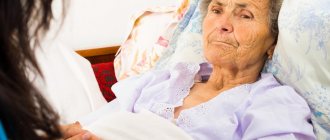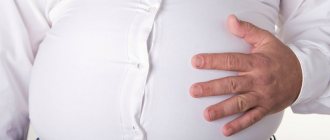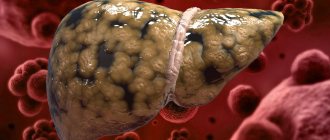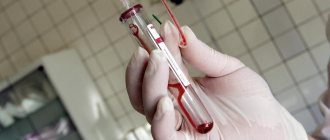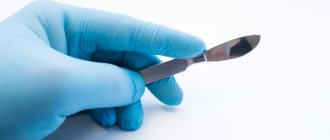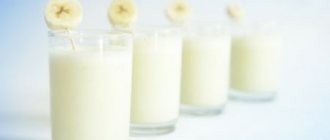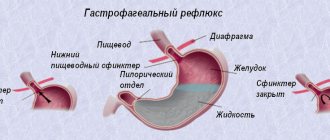Gilbert's syndrome (GS) is a hereditary pigmentary hepatosis in which the liver cannot fully process a compound called bilirubin. In this condition, it accumulates in the bloodstream, causing hyperbilirubinemia.
In many cases, high bilirubin is a sign that something is going on with your liver function. However, in GS the liver usually remains normal.
This is not a dangerous condition and does not need to be treated, although it can cause some minor problems.
Gilbert's disease affects men more often than women. Diagnosis is usually made in the late teens or early twenties. When people with GS have episodes of hyperbilirubinemia, they are usually mild and occur when the body is under stress, such as from dehydration, long periods without food (fasting), illness, vigorous exercise, or menstruation. However, about 30% of people with the syndrome have no signs or symptoms of the condition, and their disorder is only discovered when routine blood tests show increased levels of indirect bilirubin.
Other names for Gilbert's syndrome:
- constitutional liver dysfunction;
- familial non-hemolytic jaundice;
- Gilbert's disease;
- unconjugated benign bilirubinemia.
What is Gilbert's syndrome
We recommend reading: - Jaundice of newborns: causes, treatment and consequences - Causes of increased bilirubin in the blood The
disease in question is a chronic liver pathology of a benign nature, which is accompanied by periodic yellowing of the skin and sclera of the eyes and other symptoms. The course of the disease is wave-like - for a certain period of time a person does not feel any deterioration in health, and sometimes all the symptoms of pathological changes in the liver appear - this usually happens with regular consumption of fatty, spicy, salty, smoked foods and alcoholic beverages.
Gilbert's syndrome is associated with a gene defect that is passed from parents to children. In general, this disease does not lead to severe changes in the structure of the liver, as, for example, with progressive cirrhosis, but it can be complicated by the formation of gallstones or inflammatory processes in the bile ducts.
There are experts who do not consider Gilbert's syndrome a disease at all, but this is somewhat erroneous. The fact is that with this pathology there is a disruption in the synthesis of an enzyme involved in the neutralization of toxins. If an organ loses some of its functions, then this condition is called a disease in medicine.
The yellow color of the skin in Gilbert's syndrome is the effect of bilirubin, which is formed from hemoglobin. This substance is quite toxic and the liver, during normal functioning, simply destroys it and removes it from the body. If Gilbert's syndrome progresses, filtration of bilirubin does not occur; it enters the blood and spreads throughout the body. Moreover, when it gets into internal organs, it is able to change their structure, which leads to dysfunction. It is especially dangerous if bilirubin “gets” to the brain - the person simply loses some of his functions. We hasten to reassure you - with the disease in question, such a phenomenon is never observed at all, but if it is complicated by any other liver pathology, then it is almost impossible to predict the “path” of bilirubin in the blood.
Gilbert's syndrome is a fairly common disease. According to statistics, this pathology is more often diagnosed in men, and the disease begins to develop in adolescence and middle age – 12-30 years.
Features of the course of Gilbert's disease in pregnant women and children
Gilbert's syndrome is not a contraindication to pregnancy. A woman is able to successfully carry and give birth to a healthy baby. However, if one or both parents have a pathology, it is necessary to consult a geneticist. If necessary, he will prescribe a DNA test for them in order to determine the percentage of their risk of having a sick child. The genetic defect is determined in half of the children born to parents with this disease.
Throughout pregnancy, a woman should strictly adhere to a diet and take medications designed to normalize the level of bilirubin in the blood. However, you need to be careful when using medications, because some of them can cause the development of complications, which include impaired growth and development of the fetus, miscarriage, as well as partial or complete hydatidiform mole.
Yellowing of the skin is quite common in newborn babies. If one of the parents has Gilbert's syndrome, a genetic study should be carried out to make sure that it is caused by a genetic mutation and is not associated with any functional disorders.
A child with Gilbert's disease experiences pronounced yellowness not only of the skin, but also of all visible mucous membranes. Graininess may be observed in the upper eyelid area. The disease tends to be cyclical. Outside of exacerbation, clinical manifestations are completely absent.
Causes of Gilbert's syndrome
This syndrome occurs only in people who have “inherited” from both parents a defect of the second chromosome in the location responsible for the formation of one of the liver enzymes. This defect makes the percentage of this enzyme content 80% less, so it simply cannot cope with its task (converting indirect bilirubin, which is toxic to the brain, into a bound fraction).
It is noteworthy that such a genetic defect can be different - in a location there is always an insertion of two extra amino acids, but there can be several such insertions - the severity of Gilbert's syndrome depends on their number.
The synthesis of liver enzymes is greatly influenced by the male hormone androgen, so the first signs of the disease in question appear in adolescence, when puberty and hormonal changes occur. By the way, it is precisely because of the influence of androgen on the enzyme that Gilbert's syndrome is more often diagnosed in men.
An interesting fact is that the disease in question does not manifest itself “out of nowhere”; a push for the appearance of symptoms is definitely needed. And such provoking factors can be:
- drinking alcohol frequently or in large doses;
- regular use of certain medications - streptomycin, aspirin, paracetamol, rifampicin;
- recent surgical interventions for any reason;
- frequent stress, chronic fatigue, neuroses, depression;
- undergoing treatment with glucocorticosteroids;
- frequent consumption of fatty foods;
- long-term use of anabolic drugs;
- excessive physical activity;
- fasting (even for medical purposes).
Please note: these factors can trigger the development of Gilbert's syndrome, but can also influence the severity of the disease.
Causes
Disturbances in the UGT1A1 gene lead to Gilbert's syndrome. This gene provides instructions for the production of the enzyme glucuronosyltransferase, found mainly in liver cells, which is necessary for the removal of bilirubin from the body.
Bilirubin is a normal byproduct formed after the breakdown of old red blood cells containing hemoglobin, the protein that carries oxygen in the blood.
Typically, red blood cells live for about 120 days. When this period expires, hemoglobin is broken down into heme and globin. Globin is a protein stored in the body for later use. Heme must be removed from the body.
Removal of heme is called glucuronidation. Heme is broken down into an orange-yellow pigment, “indirect” or unconjugated bilirubin. This indirect bilirubin goes to the liver. It dissolves in fat.
Bilirubin in the liver is processed by an enzyme called urodine diphosphate glucuronosyltransferase into a water-soluble form. This is “conjugated” bilirubin.
Conjugated bilirubin is secreted into bile, this biological fluid helps in digestion. It is stored in the gallbladder, from where it is released into the small intestine. In the intestine, bilirubin is converted by bacteria into pigment substances - stercobilin. It is then excreted in feces and urine.
People with GS have approximately 30 percent normal glucuronosyltransferase enzyme function. As a result, unconjugated bilirubin is not sufficiently glucuronidated. This toxic substance then accumulates in the body, causing mild hyperbilirubinemia.
Not all individuals with the genetic changes that cause Gilbert's syndrome develop hyperbilirubinemia. This indicates that additional factors may be required for the condition to develop, such as conditions that further impede the glucuronidation process. For example, red blood cells may break down too easily, releasing excess bilirubin, and the impaired enzyme may not be able to do its job fully. On the contrary, the movement of bilirubin to the liver, where it would be glucuronidated, may be impaired. These factors may be associated with changes in other genes.
Apart from inheriting a damaged gene, there are no risk factors for the development of GS. The disorder is not associated with lifestyle, habits, environmental conditions or serious underlying liver pathologies such as cirrhosis, hepatitis B or hepatitis C.
Classification
Gilbert's syndrome in medicine is classified as follows:
- The presence of hemolysis is additional destruction of red blood cells. If the disease in question occurs simultaneously with hemolysis, the level of bilirubin will be increased initially, although this is not typical for the syndrome.
- Presence of viral hepatitis. If a person with two defective chromosomes suffers from viral hepatitis, the symptoms of Gilbert's syndrome will appear before the age of 13.
Prevention
It is impossible to acquire Gilbert's syndrome during your lifetime; the disease is transmitted at the genetic level. The presence of such a disease can only be determined based on appropriate blood tests. There are no preventive measures to prevent such deviation.
Experts recommend that patients at risk be attentive to their health and eliminate factors that could lead to an exacerbation of the symptoms of Gilbert's syndrome.
Video on the topic: Gilbert's disease
Such preventive measures include:
- giving up bad habits (alcohol, smoking, etc.);
- adherence to healthy eating rules;
- moderate physical activity;
- compliance with instructions for the use of drugs, the side effects of which include a negative effect on the liver;
- annual medical examination (full medical examination).
Clinical picture
The symptoms of the disease in question are divided into two groups - mandatory and conditional. Mandatory manifestations of Gilbert's syndrome include:
- patches of yellow skin that appear from time to time; if bilirubin decreases after an exacerbation, the sclera of the eyes begin to turn yellow;
- general weakness and fatigue for no apparent reason;
- yellow plaques form in the eyelid area;
- sleep is disturbed - it becomes shallow, intermittent;
- appetite decreases.
Conditional symptoms that may not be present:
- heaviness is felt in the right hypochondrium, regardless of food intake;
- headache and dizziness;
- apathy, irritability – disturbances of the psycho-emotional background;
- pain in muscle tissue;
- severe itching of the skin;
- periodically occurring trembling of the upper limbs;
- increased sweating;
- bloating, nausea;
- stool disorders - patients are bothered by diarrhea.
During periods of remission of Gilbert's syndrome, some of the conditional symptoms may be completely absent, and in a third of patients with the disease in question they are absent even during periods of exacerbation.
When is an analysis required?
A reason to suspect pathology is the presence of the following symptoms:
- change in skin and sclera color;
- discomfort in the liver area (feeling of heaviness);
- pain in the right hypochondrium;
- flatulence;
- indigestion (diarrhea or difficulty bowel movements);
- nausea, bitter taste in the mouth;
- sleep disturbance;
- dizziness;
- depression.
A distinctive sign of the pathology is jaundice, which appears from time to time (for example, after severe intoxication)
The degree of manifestation of jaundice manifests itself differently in everyone: in some, only the sclera turns yellow, in others, the entire skin and mucous membranes are stained, and in others, yellow spots appear all over the body. But it is possible that even with a significant jump in bilirubin, jaundice will be absent.
In a quarter of patients with Gilbert's syndrome, the liver is significantly enlarged and “peeks out” from under the rib, while there is no pain on palpation. Every tenth person has an enlarged spleen.
How is Gilbert's syndrome diagnosed?
Of course, the doctor will not be able to make an accurate diagnosis, but even with external changes in the skin, the development of Gilbert's syndrome can be assumed. A blood test for bilirubin levels can confirm the diagnosis - it will be elevated. And against the background of such an increase, all other liver function tests will be within normal limits - albumin level, alkaline phosphatase, enzymes indicating damage to liver tissue.
With Gilbert's syndrome, other internal organs are not affected - this will also be indicated by urea, creatinine and amylase levels. There are no bile pigments in the urine, and there will be no changes in the electrolyte balance.
The doctor can indirectly confirm the diagnosis using specific tests:
- phenobarbital test;
- fasting test;
- nicotinic acid test.
The final diagnosis is made based on the results of an analysis for Gilbert's syndrome - the patient's DNA is examined. But even after this, the doctor conducts some more examinations:
Ultrasound examination of the liver, gallbladder and bile ducts. The doctor determines the size of the liver, the condition of its surface, identifies or denies the presence of structural changes, checks for the presence of an inflammatory process in the bile ducts, excludes or confirms inflammation of the gallbladder.
- Study of liver tissue by radioisotope method. Such an examination will indicate a violation of the absorptive and excretory functions of the liver, which is characteristic of Gilbert's syndrome.
- Liver biopsy. Histological examination of a sample of the patient’s liver tissue makes it possible to deny inflammatory processes, cirrhosis and oncological changes in the organ and to detect a decrease in the level of the enzyme that is responsible for protecting the brain from the harmful effects of bilirubin.
Causes of Gilbert's disease
Considering the above, I think it is clear to everyone that the disease occurs as a result of the transmission of a gene to the child from the father or mother, therefore doctors often call the disease simple familial cholemia or non-hemolytic familial jaundice. But what provokes the manifestation of a disease that has been “dormant” for so long? After all, if you do not provoke the disease, it may not manifest itself. Children often have dietary errors, they are emotionally unstable and try to become adults at an early age due to bad habits that have a bad effect on the liver.
Treatment of Gilbert's syndrome
The attending physician will decide in what way and whether it is necessary to carry out treatment at all for the disease in question - it all depends on the general condition of the patient, on the frequency of periods of exacerbations, on the duration of the stages of remission and other factors. A very important point is the level of bilirubin in the blood.
Up to 60 µmol/l
If at this level of bilirubin the patient feels within normal limits, there is no increased fatigue and drowsiness, and only slight jaundice of the skin is noted, then drug treatment is not prescribed. But doctors may recommend the following procedures:
taking sorbents - activated carbon, polysorb;
- phototherapy – exposure of the skin to blue light makes it possible to remove excess bilirubin from the body;
- diet therapy – fatty foods, alcoholic drinks and specific foods that are identified as triggers are excluded from the diet.
Above 80 µmol/l
In this case, the patient is prescribed Phenobarbital at a dose of 50-200 mg per day for 2-3 weeks. Given the fact that this drug has a hypnotic effect, the patient is prohibited from driving a car and going to work. Doctors may also recommend the medications Barboval or Valocordin - they contain phenobarbital in small doses, so they do not have such a pronounced hypnotic effect.
When bilirubin in the blood is above 80 µmol/l, a strict diet is prescribed when Gilbert's syndrome is diagnosed. It is allowed to eat:
- fermented milk products and low-fat cottage cheese;
- skinny fish and lean meat;
- non-acidic juices;
- biscuits;
- fresh, baked or boiled vegetables and fruits;
- dried bread;
- sweet tea and fruit drinks.
It is strictly forbidden to include chocolate, cocoa, baked goods, spicy, fatty, smoked and pickled foods, any alcoholic drinks and coffee in the menu.
Hospital treatment
If in the two cases described above, treatment of a patient with Gilbert's syndrome takes place on an outpatient basis under the supervision of a doctor, then if the level of bilirubin is too high, insomnia, loss of appetite, or nausea, hospitalization will be required. Bilirubin is reduced in the hospital using the following methods:
administration of intravenous polyionic solutions;
- taking sorbents according to an individual scheme;
- prescription of lactulose drugs - Normaze or Duphalac;
- prescription of the latest generation hepatoprotectors;
- blood transfusion;
- administration of albumin.
The patient's diet is adjusted radically - animal proteins (meat products, eggs, cottage cheese, offal, fish), vegetables, fresh fruits and berries and fats are completely excluded from the menu. It is allowed to eat only soups without frying, bananas, fermented milk products with a minimum level of fat, baked apples, biscuits.
Diet
In case of GS, a healthy diet is of decisive importance.
Meals should be regular and frequent, not in large portions, without long breaks and at least 4 times a day.
This diet has a stimulating effect on gastric motility and facilitates the rapid transport of food from the stomach to the intestines, and this has a positive effect on the biliary process and the functioning of the liver in general.
The diet for the syndrome should include a sufficient amount of protein, less sweets, carbohydrates, more fruits and vegetables. Recommended are cauliflower and Brussels sprouts, beets, spinach, broccoli, grapefruit, and apples. It is necessary to consume cereals rich in fiber (buckwheat, oatmeal, etc.), and it is better to limit the consumption of potatoes. To satisfy the need for complete proteins, mild fish dishes, seafood, eggs, and dairy products are suitable. It is not recommended to completely exclude meat from the diet. It is better to exchange coffee for tea.
There is no strict restriction regarding any specific products. You are allowed to eat everything, but in moderation.
A strict vegetarian diet is unacceptable, as it will not provide the liver with the necessary amino acids that cannot be replaced. Large amounts of soy also have a negative effect on the organ.
Remission
Even if remission has occurred, patients should under no circumstances “relax” - care must be taken to ensure that another exacerbation of Gilbert’s syndrome does not occur.
Firstly, you need to protect the bile ducts - this will prevent stagnation of bile and the formation of stones in the gall bladder. A good choice for such a procedure would be choleretic herbs, the drugs Urocholum, Gepabene or Ursofalk. Once a week, the patient should do “blind probing” - on an empty stomach, you need to drink xylitol or sorbitol, then you need to lie on your right side and warm the area of the anatomical location of the gallbladder with a heating pad for half an hour.
Secondly, you need to choose a competent diet. For example, it is imperative to exclude from the menu foods that act as a provoking factor in the event of an exacerbation of Gilbert's syndrome. Each patient has a different set of products.
Treatment
Gilbert's syndrome is not a life-threatening disease . Even the symptoms of the disease occur with minimal discomfort, and sometimes remain unnoticed for a long time. Yellowness of the skin causes psychological anxiety to patients.
Drugs
In case of exacerbation of Gilbert's syndrome, it is recommended to take the drug Phenobarbital .
The dosage and course of treatment are established by a specialist based on the existing clinical picture. Long-term use of this medication or its uncontrolled use can adversely affect the functioning of the liver and the condition of the nervous system. In addition, the product has a toxic effect on the body.
Patients with Gilbert's syndrome are recommended to take Ursosan several times a year. This drug prevents the formation of stones in the liver and provides it with powerful protection from the effects of negative factors.
The medication has a beneficial effect on the composition of bile. The prophylactic course of taking it lasts several weeks. The use of Ursosan in the treatment of Gilbert's syndrome must be agreed with the attending physician.
The course of treatment of Gilbert's syndrome can be supplemented with drugs from the following groups:
- choleretic agents;
- barbiturates;
- hepatoprotectors;
- enterosorbents;
- diuretics;
- vitamin B;
- drugs to improve digestion.
Treatment with folk remedies
It is recommended to supplement the treatment process for Gilbert's syndrome with a special diet. The patient should receive the maximum amount of vitamins and beneficial components from food. Preservatives and unhealthy foods are completely excluded from the diet. Food should be prepared only by boiling or baking.
Infusions of the following types of herbs help normalize bilirubin levels:
- calendula;
- immortelle;
- tansy;
- chicory;
- barberry;
- rose hip;
- corn silk.
You can brew these ingredients in the traditional way - one teaspoon of the mixture per glass of boiling water. Decoctions are prepared by infusion or short boiling. It is recommended to take folk remedies in courses of several weeks. The decoction should be consumed at least three times a day, one glass each day.
Doctors' forecasts
In general, Gilbert's syndrome proceeds quite well and is not the cause of the patient's death. Of course, there will be some changes - for example, with frequent exacerbations, an inflammatory process may develop in the bile ducts, and stones may form in the gall bladder. This negatively affects the ability to work, but is not a reason to register disability.
If a family has a child with Gilbert's syndrome, then before the next pregnancy the parents must undergo genetic testing. The couple needs to undergo the same examinations if one of the spouses has this diagnosis or there are obvious symptoms of it.
Gilbert's syndrome and military service
As for military service, Gilbert's syndrome is not a reason to receive a deferment or a ban on military service. The only warning is that a young man should not physically overexert himself, go hungry, or work with toxic substances. But if the patient is going to build a professional military career, then he is not allowed to do so - he simply will not pass the medical examination.
Signs and manifestations
Gilbert's syndrome usually occurs in a latent form and is not detected until the concentration of bilirubin in the blood reaches a critical level. The disease has a chronic course, in which short-term periods of exacerbation are followed by long-term remission. The disease manifests itself with symptoms of asthenovegetative, dyspeptic and icteric syndromes. The general condition of patients with Gilbert's syndrome most often remains satisfactory.
- Jaundice is the main and often the only clinical sign of the disease, occurring after activation of the pathological process. It has an intermittent nature and varying degrees of severity. Some patients have only subicteric sclera, while others have bright diffuse jaundice of the skin. Jaundice occurs sporadically, intensifies under the influence of negative factors and disappears on its own. A change in skin color is often accompanied by itching and the appearance of yellow plaques on the eyelids - xanthelasma.
- Manifestations of asthenovegetative syndrome include: weakness, rapid and causeless fatigue, insomnia, myalgia, hand tremors, hyperhidrosis, cephalgia, dizziness, tachycardia, indifference and indifference, followed by anxiety, irritability, panic, and aggression.
- Signs of dyspepsia are refusal to eat, belching, nausea, bitterness in the mouth, flatulence, discomfort in the liver and abdomen, diarrhea.
The listed clinical signs do not always occur in patients in full. The symptoms of the syndrome depend on the individual characteristics of the body, the age of the patient, and the presence of concomitant diseases.
In most patients, the liver becomes enlarged. It protrudes from under the edge of the costal arch, but remains painless. Palpation determines its homogeneous structure without any features. In some cases, enlargement of the spleen and disruption of the functions of the main structures of the hepatobiliary zone are possible. In 30% of patients, the syndrome is asymptomatic and goes undetected for a long time.
Preventive measures
It is impossible to somehow prevent the development of Gilbert's syndrome - this disease occurs at the level of genetic abnormalities. But it is possible to take preventive measures in relation to the frequency of exacerbations and intensity of manifestations of this disease. These measures include the following recommendations from experts:
adjust your diet and eat more plant foods;
- avoid excessive physical exertion, if necessary, change your type of work;
- avoid frequent infection with viral infections - for example, you can and should harden yourself, strengthen the immune system;
- exclude injection drugs, unprotected sexual intercourse - these factors can lead to infection with viral hepatitis;
- try to stay less in direct sunlight.
Gilbert's syndrome is not a dangerous disease, but it requires some restrictions. Patients must be monitored by a doctor, undergo regular examinations and follow all medication prescriptions and recommendations of specialists.
Tsygankova Yana Aleksandrovna, medical observer, therapist of the highest qualification category
58, total, today
( 46 votes, average: 4.80 out of 5)
Esophageal burn: causes, symptoms, first aid and treatment
Travelers' diarrhea: symptoms, treatment, prevention
Related Posts
Forecasting and preventive measures
Gilbert's syndrome has a favorable prognosis for recovery and a doubtful prognosis for stable performance. Despite the fact that this disease has a chronic course and is not completely curable, it does not lead to gross destructive disorders and persistent irreversible liver dysfunction. The syndrome does not end with disability and death. Over time, it is possible to develop cholangitis or calculous cholecystitis, which worsen the general health and reduce the ability of patients to work.
Prevention of pathology consists of examining married couples planning pregnancy and having this disorder in previous generations. Medical genetic counseling allows you to assess the risk of developing the syndrome in future children.
Preventive measures to prevent exacerbation of the process:
- Optimization of work and rest,
- Proper nutrition,
- Full drinking regime,
- Hardening, which reduces the risk of developing viral infections,
- Avoiding heavy physical activity
- Protecting the body from stress, surges of emotions, and moral trauma.
Gilbert's syndrome is an incurable congenital pathology that does not pose a threat to the patient's life. When it worsens, you must take medications prescribed by your doctor, and during remission, follow all medical recommendations. If you lead a healthy lifestyle, don’t overwork, eat right, stay in good physical shape and be positive, then you can forget about your existing illness forever.
Treatment of the disease
After the accurate results that the diagnosis shows, it is necessary to begin treating the disease. Only a specialist can distinguish an individual therapy schedule based on individual indicators. In addition, it is necessary to follow the correct menu (diet 5), love sports and follow the doctor’s recommendations. In this case, the effect that the tablets have will be better. Treatment for manifestations of a homozygous chromosome is selected according to the degree of deviation:
- There are algorithms and treatment regimens for this pathology.
up to 60 mm/k/mol: - diet for Gilbert's syndrome;
- sorbents;
phototherapy;
- "Corvalol";
If a doctor treats Gilbert's syndrome in children or adults in a hospital, a wider range of drugs is expected to be used:
- polyion injections;
- hepatoprotectors (“Ursosan”);
- sorbents (“White Coal”, “Smecta”);
- antitoxic drugs (Normaze, Duphalac);
- administration of albumin.
In newborns, a homozygous abnormal chromosome may be manifested by fever, so an autonomic antipyretic drug will be needed.
Features of the analysis
Blood tests help identify pathology at an early stage of development, even in the absence of characteristic symptoms. There are several types of studies that determine Gilbert's syndrome.
Rules for taking the analysis
In order for the study to show a reliable result, it is recommended to follow the rules for submitting biomaterial:
- The analysis is performed in the morning. Blood is donated on an empty stomach; the interval between the last meal and the test should be at least 12 hours. At this time, you should also not drink tea, coffee or other drinks. The restriction on the use of clean water without gas does not apply;
- Within a few days, they stop eating fatty foods. Fast food and all junk food are also excluded from the diet;
- You should not be nervous, overstrained or overtired a few days before the test. This will distort the test results. It is recommended to avoid stressful situations and refuse to exercise in the gym, as well as heavy physical work;
- A few days before the analysis, drug therapy is stopped. In particular, stop taking medications that affect the concentration of bilirubin, otherwise the tests will show an unreliable result.
General blood test
A general study of this substance is not a diagnostic analysis of this liver pathology. It only shows that pathological processes are occurring in the liver. For this reason, if a general blood test shows problems associated with this internal organ, additional studies are prescribed.
Familial jaundice is indicated by the following indicators in a general blood test:
- Increased change in hemoglobin reference values;
- An increase in the level of bilirubin in the blood relative to the norm;
- Increased change in the reference values of immature red blood cells in the blood.
Against the background of these indicators, ESR, as well as the concentration of platelets and leukocytes, does not change.
Blood biochemistry
In a biochemical blood test, the following indicators indicate the disease:
- Bilirubin. With the syndrome under consideration, the concentration of this element increases. However, an increase in the content of this substance is also observed with other problems associated with the liver. For this reason, a biochemical blood test cannot be the main test for diagnosing the disease;
- Alkaline phosphatase. This indicator increases with illness;
- ALT and AST. With pathology, the concentration of substances increases.
Blood biochemistry also does not diagnose pathology. If the study shows a positive result, additional tests and analyzes are prescribed.
Genetic test
Genetic analysis for Gilbert's syndrome is the only way to diagnose the pathology. The analysis helps detect a mutated gene that affects the synthesis and activity of hyaluronic acid.
A genetic test for Gilbert's syndrome is prescribed in the following cases:
- Suspicion of the occurrence of pathology, if corresponding symptoms appear;
- The appearance of signs of liver disease to exclude or confirm the disease;
- Before drug therapy, if drugs that have a hepatotoxic effect are used for treatment;
- To predict side effects when taking anticancer drugs, in particular, the use of Irinotecan, used for oncological blood pathologies in a malignant form;
- Non-infectious jaundice in mild form;
- Chronic jaundice, the development of which is inhibited by barbiturates;
- If other studies have shown increased bilirubin concentrations;
- If Gilbert's syndrome is present in the patient's medical history;
- To assess the effectiveness of the therapy.
The study is also prescribed if the patient is prescribed medications for a long time, as a result of which the liver will experience increased stress.
The biomaterial for the study is venous blood. The required amount is 2-3 ml. The biomaterial is checked using the PCR method.
The results of the study are deciphered as follows:
- UGT1A1 (TA)6/(TA)6 – gene composition does not change, pathology is not diagnosed;
- UGT1A1 (TA)6/(TA)7 – an additional element was identified in the gene composition, which indicates the possible occurrence of a disease that will occur in a mild form;
- UGT1A1 (TA)6/(TA)7 – indicates a high probability of a pathology with a severe course.
There is no preparation for genetic testing. This is due to the fact that nutrition, medications, physical and psycho-emotional state cannot affect the result of the study. The analysis gives a 100% accurate result. Only this study is used to diagnose the disease. Other tests only indicate problems with the liver.
The research is not carried out free of charge. The cost of genetic analysis for Gilbert's syndrome depends on the pricing policy of the laboratory that conducts the study. The average price is 2500 rubles.
Instrumental diagnostics
The task of such tests for any jaundice is, first of all, to find out what caused it. To do this, take a standard biochemical blood test or liver profile. Total bilirubin will be increased with any jaundice, but the ratio of direct and indirect bile pigment in the blood will allow us to draw conclusions about the causes of hyperbilirubinemia.
It is important for the doctor to collect an anamnesis: if among the patient’s immediate relatives there are people with Gilbert’s syndrome, then the likelihood of detecting this diagnosis in this case increases. However, if there are no such relatives, the disease can also be detected: it can be hidden and never manifest. However, it is possible that a carrier of the altered UGT 1A1 gene developed jaundice for a completely different reason. Therefore, as part of the examination, a clinical blood test is taken and an ultrasound of the abdominal organs is performed.
Be sure to pay attention to the examination data: with Gilbert's syndrome, the liver does not enlarge, there is usually no intense abdominal pain, the temperature is normal, and there are no changes in the blood count characteristic of inflammation.
When all preliminary research data indicate Gilbert's syndrome, the diagnosis is confirmed. To do this, blood is taken and the gene that causes simple hereditary choleemia is examined. The test for Gilbert's syndrome is called "Detection of the (TA)6/7 mutation in the UGT1A1 gene." If changes characteristic of this disease are detected, and specifically an additional area of the TA, the diagnosis is confirmed. The form of the disease is also specified: homo- or heterozygous. But sometimes the results of this relatively inexpensive research are questionable.
When a mutation (TA)6/7 is detected in the UGT1A1 gene, it is determined how many TA fragments the gene encoding the enzyme necessary for binding bilirubin consists of. Normally, there are 6 such fragments. If their number is not a multiple of three, then the gene cannot correctly reproduce the necessary enzyme. This genetic pathology is called a reading frame mutation. Most often, Gilbert's syndrome is caused by it, and specifically by the insertion (insertion of an additional fragment into the gene) UGT1A1.
However, there are other mutations that cause the same condition. Therefore, if the mutation (TA)6/7 is not confirmed, and the clinical picture directly indicates Gilbert's syndrome, a more expensive clarifying study is performed, for which blood is also taken. The analysis is also used in cases where the patient requires chemotherapy with irinotecan or other drugs that may be toxic for patients with non-hemolytic familial jaundice. The result is necessary for the doctor to determine the balance of harm and benefit in each specific case.
Preparation for clinical and biochemical blood tests is standard: the day before it is better to go on a diet for 2-3 days, immediately before taking blood, go on a fasting diet for 8-12 hours. Arrive at the treatment room a little early and relax.
A blood test for Gilbert's syndrome (genetic analysis) does not require special preparation.
Studies using various devices are usually prescribed to confirm the diagnosis. There are several methods that allow you to determine Gilbert's syndrome.
This study is carried out to determine the condition of the liver. Ultrasound shows the dimensions and existing lesions of the organ. The study is prescribed at any age, since it has no contraindications and does not cause side effects.
In order for an ultrasound to show a reliable result, you should prepare for the study in advance:
- In a few days, remove from the menu all foods that cause flatulence;
- 2-3 days before the ultrasound, take medications that reduce gas formation;
- The day before the test, take a laxative or give an enema if you have problems with bowel movements.
The essence of the study is the collection of biomaterial using a probe, after which an analysis of the biological fluid, which is formed by gastric and pancreatic juice, as well as bile, is performed. This helps determine the condition of the liver and existing problems.
There are rules for preparing for research that are not recommended to be violated:
- Biological material is handed over in the morning. You should not eat before the test. The last meal should take place the day before no later than 18.00. During this period, all drinks are also excluded. In the evening you can drink plain water without gas, in the morning you can’t drink anything;
- 5 days before donating the biomaterial, stop taking any medications that stimulate bile production. Also stop taking laxatives and antispasmodics;
- The day before probing, the patient is administered 0.5 ml of atropine. After this, the subject drinks warm water with xylitol.
There are two types of duodenal intubation:
- Classic. In this case, the biomaterial is taken simultaneously from the ducts, gallbladder and duodenum;
- Factional. Biomaterial is collected 5 times every 8 minutes.
In case of liver pathologies, the study shows a change in the composition of bile and a disruption in the transport of fermented substances to the intestines.
Biopsy
The essence of the method is puncture of the gland for further study of the biomaterial. This analysis is usually performed to exclude cirrhosis and inflammation of the liver. General anesthesia is used to collect biomaterial, so the procedure is not popular.
Symptoms
The main manifestation of Gilbert's pathology is jaundice of varying severity. It occurs on the sclera, and the skin also becomes stained. Jaundice is not accompanied by itching and worsens after physical or mental stress, poor diet, or alcohol consumption.
With Gilbert's syndrome, symptoms include fatigue, weakness, and dizziness. Sleep is disturbed and insomnia develops.
There are complaints about the functioning of the gastrointestinal tract. These include discomfort in the right hypochondrium, loss of appetite, and heartburn. Digestion worsens, which provokes the development of nausea, vomiting, the appearance of a bitter taste in the mouth, and belching.
Symptoms of Gilbert's disease are characterized by stool disturbances: there is a tendency to constipation or, conversely, to diarrhea. There is bloating and a feeling of fullness in the stomach. The liver increases in size. Stones form in the gallbladder and its ducts due to disruption of the normal outflow of bile.
What is the essence of the study?
This is a rather technically complex analysis and it consists in determining the nucleotide sequence of certain gene loci using the pyrosequencing technique. As already mentioned, with Gilbert's syndrome there is a hereditary gene defect, which leads to characteristic symptoms.
If we look at Gilbert's syndrome in more detail, the deciphering of the genetic analysis may look like this. Most often, the cause of the disease is the rs8175347 polymorphism, which leads to a decrease in enzyme activity. If a homozygous condition is detected and in the absence of severe symptoms, there is no reason to make a diagnosis of Gilbert's syndrome. In the heterozygous state, a more pronounced decrease in the level of the enzyme is observed, and this provokes the clinical symptoms of the syndrome.
From a genetic point of view, this is a fairly common disease - up to 10% in the population, and belongs to diseases with an autosomal recessive type of inheritance. This means that for a child to develop a disease, both parents must be carriers of the pathologically altered gene, but the parents themselves most likely will not experience symptoms of the disease. Or, as an option, one parent is a carrier of the syndrome, and the other is sick.
To diagnose the pathology, if a genetic blood test for Gilbert's syndrome has not been performed, additional tests are also prescribed. The essence of such tests is the use of certain drugs that affect the level of bilirubin in the blood.
Drug tests
There are several types of tests that help diagnose Gilbert's syndrome:
- The use of drugs containing nicotinic acid. The drug in an amount of 50 mg is injected into the bloodstream through a vein. Three hours later, the blood is taken for analysis. If the study showed an increase in bilirubin concentration several times, Gilbert's syndrome, hepatitis or hemolysis are suspected;
- The use of products containing phenobarbinal. The drug is used in tablets. The product is consumed for 5 consecutive days before the study. The recommended dosage is 3 mg per 1 kg of body weight. If after the analysis a decrease in the concentration of bilirubin in the blood is detected, a positive test result is determined;
- Use of products that contain refampicin. The essence of testing is to inject 900 mg of the drug into the bloodstream. If the concentration of bilirubin in the blood increases, this means that the test for Gilbert's syndrome showed a positive result.
Other samples
There is another study for diagnosing Gilbert's syndrome - a non-drug test. In this case, no drugs are used. For testing, fasting blood is taken and the bilirubin level is determined. After this, the patient should not consume anything other than pure still water for 2 days.
If it is not possible to maintain such a strict diet, you are allowed to eat, but the calorie content of the daily diet should not exceed 400 kcal. After this, a repeat study is carried out. The test will be positive if the analysis shows an increase in pigment levels by more than 2 times.
A blood test for Gilbert's syndrome helps to identify pathology in the early stages of its occurrence and begin therapy. In this case, doctors give a favorable prognosis, but only if certain nutritional rules are observed.
Description of the disease
The syndrome is a genetically determined, inherited pathological process, the main manifestation of which is a significant increase in bilirubin levels.
It is important to know! The main cause of the disease is a defect in the genes responsible for the metabolism of pigment substances in the body.
The average value in patients with Gilbert's syndrome is about 100 µmol/l. In this case, bilirubin not associated with hemoglobin predominates.
The described pathology is considered by many doctors not as a disease, but as a unique physiological feature of the body. The disease is rarely accompanied by a pronounced clinical picture. The main manifestation is jaundice, which is permanent.
Possible symptoms include:
- Bitterness in the mouth.
- Flatulence.
- Enlargement of the liver.
- Rare occurrence of nausea with vomiting.
- Belching after eating with a bitter taste.
- Feeling of overeating.
- Diarrhea alternating with constipation.
Neurological signs characteristic of many liver diseases are extremely rare. These include fatigue, weakness, occasional dizziness, and sleep disturbances.
The pathology occurs in a chronic form. During the period of remission, the syndrome does not manifest itself in any way. Exacerbations occur when exposed to certain factors. These include:
- Past illnesses and injuries.
- Surgical interventions.
- Increased physical activity.
- Drinking alcoholic beverages.
- Acute intoxication.
- Poor nutrition.
- Infectious diseases.
- Stress.
Advice! You should get tested for Gilbert when the first symptoms appear. As a rule, the disease manifests itself at an early age. In this case, diagnosis does not cause significant difficulties.
Symptoms of Gilbert's disease
These photos show signs of Gilbert's disease
Most often, the disease does not manifest itself or is expressed only in dyspeptic symptoms (i.e., in a group of digestive disorders), which are easily eliminated with the help of medications. Here are the main symptoms of Gilbert's syndrome:
- yellowness of the skin, including the sclera of the eyes, conjunctiva and mucous membranes;
- sleep disturbance, insomnia (lack of sleep);
- dyspeptic symptoms of belching air, heartburn, nausea, stool changes from constipation to diarrhea);
- flatulence;
- feeling of a full stomach;
- pain in the liver area, dull and drawing in nature;
- liver enlargement, ascites (presence of free fluid in the abdomen) - this happens extremely rarely.
Yellowness of the mucous membranes is the main sign of liver failure, which requires diagnosis and treatment before the disease progresses.
If you have the above symptoms, you must contact a gastroenterologist to undergo a physical examination, laboratory tests, and instrumental research.
Diagnostic measures
The disease needs to be diagnosed differentially, since pain in the right side, yellowness of the skin, and dyspeptic disorders are inherent in various liver pathologies in humans. The diagnosis is made on the basis of the clinic, family history, laboratory and instrumental diagnostic measures.
Laboratory
After collecting anamnesis, laboratory tests are prescribed.
The normal level of total bilirubin varies from 3.4 to 17.1 µmol. Against the background of Gilbert's syndrome, the concentration increases in the form of an indirect fraction and ranges from 34 to 85 µmol/l. Other biochemical parameters (albumin, alkaline phosphatase, AST, ALT and cholesterol) were within normal limits.
A decrease in bilirubin content when taking phenobarbital and its increase by 50-100% after fasting or a diet with a low calorie intake, as well as intravenous administration of nicotinic acid, indicates Gilbert's disease. Using PCR diagnostics, it is possible to determine the polymorphism of the defective gene.
Differential diagnosis is carried out to distinguish from Dubin-Johnson and Rotor syndromes.
Instrumental
Hardware studies are included in a set of diagnostic measures so that the doctor gets a complete picture.
The following methods help diagnose benign hyperbilirubinemia:
- Ultrasound of the liver, bile ducts and gallbladder. The study reveals the size of the liver, the condition of the structure/surface, and checks for the presence of an inflammatory reaction in the gallbladder and gland.
- Radioisotope research. With its help, it is possible to identify a violation of the excretory and absorptive functions of the gland, which once again confirms the development of a hereditary syndrome.
Sometimes a liver biopsy is recommended for an adult patient. Histology is required to exclude cirrhosis and cancer in the presence of suspicious neoplasms.
Symptoms, causes, prevalence, prognosis
The syndrome, in which patients suffer from gastrointestinal disorders and turn yellow after overload, was described by the French hepatologist Nicolas Augustin Gilbert and his colleagues Pierre Lerebullet and Joseph Castagny.
Therefore, in the literature you can find the names of this syndrome in honor of two doctors: Gilbert-Lerebulle, and also Gilbert-Meulengracht. Here the second name belongs to a Danish specialist who added and clarified the description of the disease. Gilbert's syndrome is a common genetic pathology that affects 2-5% of Europeans and 1-5% of all humanity. Most common among the Negroid race (3-6%). Men suffer from it 8-10 times more often than women.
Nonspecific symptoms of Gilbert's syndrome are a variety of digestive disorders: abdominal pain, stool disorders, nausea. All this is accompanied by increased fatigue, and occasionally anxiety. As the condition worsens, jaundice develops.
Jaundice is associated with increased levels of bilirubin in the blood and body tissues, but the condition itself is not that bad. Jaundice attracts attention because it indicates a severe pathological process in the body: liver damage or the death of a large number of red blood cells in the blood, which is not present in Gilbert's syndrome.
The cause of the disease is a defect in the UGT 1A1 gene, which encodes a necessary enzyme. The disease is inherited in an autonomic recessive manner. If a specific gene is damaged in both chromosomes (homozygous carriage), the clinical manifestations will be more pronounced; if only in one, the disease can occur latently and be detected by chance by exceeding the level of bilirubin in blood tests taken for another reason.
Fact! Most often, the disease first appears at the age of 15-25, after stress: an infectious disease, physical overload, fasting, drinking large amounts of alcohol or fatty foods.
It is this disease that Europe owes to the emergence of the idiom “bilious man.” An increase in unconjugated bilirubin has a toxic effect on the central nervous system, as a result of which patients can become overly irritable, and nervous overload can lead to jaundice. For example, Napoleon Bonaparte suffered from this disease. Of the literary characters, one can remember Pechorin, who somehow did not sleep all night, and the next morning was “yellow, like an orange.”
Diagnostics [ edit | edit code ]
Clinically manifests itself no earlier than at the age of 20 years. Often the patient is unaware that he has jaundice until it is discovered during clinical examination or laboratory tests.
Physical examination methods [edit | edit code]
- survey - indication in the anamnesis of periodic episodes of moderate jaundice, which occurs more often after physical overexertion or an infectious disease, including influenza, after prolonged fasting or following a low-calorie diet, however, in patients with hemolysis, the level of bilirubin does not increase during fasting;
- examination - subicteric (slight yellowness) of the mucous membranes and skin.
Laboratory research [ edit | edit code]
- general blood analysis;
- general urine analysis;
- bilirubin level in the blood - an increase in the level of total bilirubin due to the indirect fraction;
- fasting test - increase in bilirubin level during fasting - For 48 hours, the patient receives food with an energy value of 400 kcal/day. On the first day of testing on an empty stomach and two days later, serum bilirubin is determined. When it rises by 50 - 100%, the sample is considered positive.
- test with phenobarbital - a decrease in bilirubin levels while taking phenobarbital due to the induction of liver conjugating enzymes;
- test with nicotinic acid - intravenous administration causes an increase in bilirubin levels due to a decrease in the osmotic resistance of red blood cells;
- stool test for stercobilin - negative;
- molecular diagnostics: DNA analysis of the UDFGT gene (a mutation is detected in two alleles - an increase in the number of TA repeats more than 6TA/6TA);
- blood enzymes: AST, ALAT, GGTP, alkaline phosphatase - as a rule, within normal values or slightly increased.
If indicated:
- serum proteins and their fractions - an increase in total protein and dysproteinemia may be observed;
- prothrombin time is within normal limits;
- markers of hepatitis B, C, D viruses - no markers;
- bromsulfalein test - decrease in bilirubin secretion by 20%.
Instrumental and other diagnostic methods [edit | edit code]
- Ultrasound of the abdominal organs - determination of the size and condition of the liver parenchyma; size, shape, wall thickness, presence of stones in the gallbladder and bile ducts.
If indicated:
- percutaneous puncture biopsy of the liver with morphological assessment of the biopsy sample - to exclude chronic hepatitis and cirrhosis of the liver.
Consultations with specialists Mandatory:
If indicated:
- clinical geneticist - to verify the diagnosis.
Differential diagnosis [edit | edit code]
(Crigler-Nayyar, Dabin-Johnson, Rotor syndrome), viral hepatitis, obstructive and hemolytic jaundice. The hallmark of Gilbert's syndrome is familial, unconjugated, nonhemolytic hyperbilirubinemia. A differential diagnostic criterion to exclude viral hepatitis is the absence in the blood serum of markers of the replicative and integrative stages of development of hepatitis B, C and delta viruses. In some cases, a puncture biopsy of the liver is necessary to distinguish between Gilbert's syndrome and chronic hepatitis with little clinical activity. Obstructive jaundice is supported by conjugated hyperbilirubinemia, the presence of a tumor, calculosis, strictures of the biliary system and pancreas, which are confirmed by ultrasound, endoscopy, CT, etc.
Differential diagnosis of Gilbert's syndrome with Dabin-Johnson and Rotor syndromes:
- Pain in the right hypochondrium is rare, if present it is aching.
- There is no itching of the skin.
- Liver enlargement is typical, usually insignificant.
- Enlarged spleen - no.
- Increased bilirubin in blood serum - mainly indirect (unrelated)
- Bilirubinuria is absent.
- Increased coproporphyrins in urine - no.
- Glucuronyltransferase activity is decreased.
- Bromsulfalein test is often normal, sometimes there is a slight decrease in clearance.
- Cholecystography is normal.
- Liver biopsy: normal or lipofuscin deposition, fatty degeneration.
Disease prognosis and prevention
In most cases, the prognosis is favorable, but is determined by the course of the disease. The increased level of bilirubin in the blood persists forever. The formation of pathological changes in the liver is not observed. When insuring people with such a diagnosis, they are classified as a standard risk group.
The susceptibility of patients with the syndrome to various hepatotoxic influences (alcohol products, medications) has been proven. In some patients, the risk of psychosomatic disorders, cholelithiasis, and inflammation in the biliary tract increases.
Parents of children who suffer from benign hyperbilirubinemia should consult a geneticist before planning another pregnancy.
The cause of the disease is a gene defect that is passed on by parents to the child, so the pathology cannot be prevented. The main preventive measures are aimed at preventing exacerbation and prolonging the remission period. This goal is achieved by eliminating provoking factors.
Therapeutic measures
Treatment of Gilbert's syndrome depends on the symptoms and complications of the pathology. The main goal is to reduce the concentration of indirect bilirubin in the blood using various methods. Patients are prescribed a diet, regimen adjustment, and medications. Folk remedies and homeopathy are recommended as additional methods.
Medication support
In order to increase the synthesis of transport protein, patients are prescribed the drug Phenobarbital. The medicine is dispensed only with a doctor's prescription. It is necessary to take drugs from the group of barbiturates in the dosages prescribed by the doctor.
Gilbert's disease can be treated with milder analogues:
- "Barboval";
- "Corvaldin";
- "Corvalol";
- "Valocardine".
It is recommended to reduce bilirubin levels with choleretic medications:
- "Ursohol";
- "Ursosan";
- "Artichol".
Patients are prescribed the following medications:
- hepatoprotectors: “Essentiale N”, “Selymarin”, “Leviron Duo”;
- vitamin complexes;
- alpha-lipoic acid: “Berlition”, “Espalipon”;
- adsorbents: “Enterosgel”, “Smecta”, “Activated carbon” tablets;
- introduction of "Albumin";
- homeopathy prescription: “Cholential”, “Hepatocholan”;
- enzymes: “Mezim”, “Festal”.
Treatment is supplemented with choleretic decoctions based on immortelle, milk thistle, oats, and chicory. Folk remedies are taken after consultation with a doctor. In severe cases, patients are prescribed exchange transfusions and phototherapy.
Diet
The diet for Gilbert's syndrome excludes foods that burden the hepatobiliary system. Fried, salty and fatty foods are prohibited. Patients should not consume smoked meats, rich broths, seasonings, lard, mushrooms, cream, nuts, chocolate and candy. The menu includes steamed and boiled food. Patients can:
- lean fish and meat;
- meatballs;
- dairy products;
- vegetarian soups;
- vegetables and sweet fruits;
- dried fruits;
- honey;
- marshmallow;
- cereal porridge.
Dietary table No. 5 allows you to consume butter in small quantities. It is recommended to eat frequently and in small portions.
Attention! Drinking alcohol and smoking during treatment is prohibited.
Remission period
After the symptoms of the disease disappear and stable remission occurs, patients are still shown hepatoprotectors and diet for three months. Restrictions:
- heavy physical activity;
- lifting weights;
- prolonged exposure to the sun.
An absolute contraindication is the consumption of alcoholic beverages and hepatotoxic drugs (Panadol). Patients are also prescribed medications based on bile acid: Ursofalk, Ursohol. Nutrition should be selected in such a way as not to provoke an exacerbation.
Classification and stages of development of Gilbert's syndrome
There is no generally accepted classification of Gilbert's syndrome, but the genotypes of the syndrome can be conditionally divided by polymorphism.
Gilbert's syndrome is a hereditary disorder of bilirubin metabolism in the human body, resulting from a defective structure of microsomal liver enzymes. Leads to the occurrence of a benign form of hyperbilirubinemia.
In most cases, patients exhibit jaundice of the skin and complain of discomfort, pain or heaviness in the right side. Additionally, dyspeptic and asthenovegetative disorders develop.
The diagnosis is confirmed on the basis of clinical data, family history, blood tests, instrumental diagnostics, and functional tests. Treatment is complex and includes a number of drugs from various pharmacological groups.
Let's look at the pathology - Gilbert's syndrome, and what it is, we'll tell you in simple words about the mechanism of development, pathogenesis, causes and features of the therapeutic strategy.
Forecast
Fortunately, the prognosis of the disease is favorable, but high levels of bile pigment will remain throughout life. If treatment is carried out correctly, using phenobarbital, bilirubin levels remain normal.
Any deviation from the diet and recommendations may result in the return of jaundice and dyspeptic symptoms. To avoid relapse, it is important to adhere to a healthy lifestyle and try not to provoke gastrointestinal disorders. The disorder is not dangerous in most cases.
In this article, we tried to tell you in detail, in simple language, what Gilbert’s disease is, highlight the symptoms and treatment of this disorder, we hope the information in this material was useful to you.
Forecast [edit | edit code]
The prognosis is favorable, depending on how the disease progresses. Hyperbilirubinemia persists for life, but is not accompanied by an increase in mortality. Progressive changes in the liver usually do not develop. When insuring the lives of such people, they are classified as a normal risk group. When treated with phenobarbital or cordiamine, bilirubin levels decrease to normal. It is necessary to warn patients that jaundice may appear after intercurrent infections, repeated vomiting and missed meals. High sensitivity of patients to various hepatotoxic effects (alcohol, many drugs, etc.) was noted. It is possible to develop inflammation in the biliary tract, cholelithiasis, and psychosomatic disorders. Parents of children suffering from this syndrome should consult a geneticist before planning another pregnancy. The same should be done if relatives of a married couple planning to have children are diagnosed with the syndrome.
What is Gilbert's syndrome? We will discuss the causes, diagnosis and treatment methods in the article by Dr. Vasiliev R.V., a general practitioner with 12 years of experience.
Military service with Gilbert's syndrome
The syndrome is not included in the list of pathologies that exclude military service. If relapses are frequent and symptoms are severe, young men may be taken to units where there is no increased physical activity. If we talk about the contract, then, most likely, a man with such a diagnosis will not be hired, since there will be a constant danger of exacerbation of the disease.
Patients need constant therapeutic nutrition and reduced physical activity, and such conditions are not always provided in the army. After passing the commission and confirming the diagnosis, the conscript is included in group B with certain restrictions due to health reasons. This syndrome does not affect service life. An exception may be a relapse of the disease and deterioration in health.
